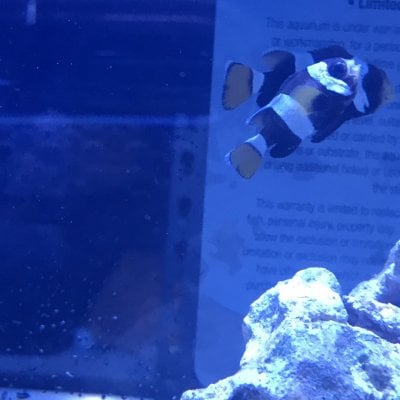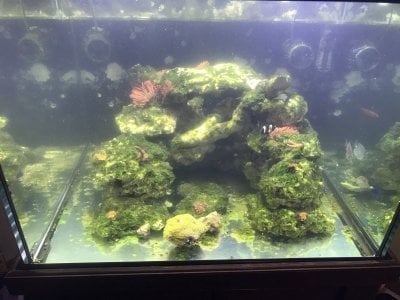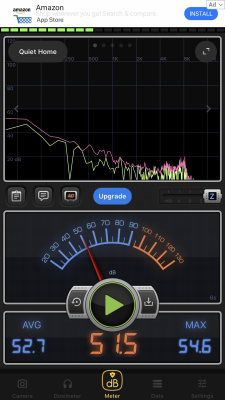This is my 150 Deep Dimension Extermination project. The goal of this tank is to support a pair of Latz clowns, a gigas clam, a bunch of BTA’s, maybe a future H. magnifica, and primarily SPS corals.
I accepted a rock with one visible aptasia when I was new to the hobby, and spotting an occasional aptasia wan’t an issue for quite a while. A quick shot of kalk and they were gone. Well, until there were thousands or more. I tried drying out some rock, curing it for a while, then swapping my rock out. That put a notable dent in them for about a year before they started coming back more quickly than I could eradicate them and I eventually came to the conclusion that I would need to perform a full reboot to stand a chance. This created the opportunity to address my energy consumption concerns, eliminating my basement sump in favor of a closed loop filtration system consisting of a Royal Exclusiv RD2-230 return pump, ARID N-24 algae reactor, Geo calcium reactor, and inline Apex probe holders. I also plumbed in provisions so that I can plumb in my Lifereef skimmer externally in case I decide to run it. The display side will have 2 Radion G4 Pros and 2 Tunze 6255’s for water movement.
The first phase of the project was to dry out an adequate amount of rock to start a new tank. I removed a couple rocks at a time until I had enough and let them dry for months. Once I was ready, I set up a 40 breeder, moved my rock, water, fish, and some corals into the tank, and began cutting up the plumbing for my display. Everything looked good. My fish were swimming about and I went to bed around midnight to get a fresh start in the morning. Well, Murphy struck and all of my fish perished. I suspect it was lack of oxygen, even though there was tons of surface agitation from my MP40. I’m not sure what I could have done, but I suspect that my basement has very high CO2 levels as I’ve always struggled with low pH even when running an airline outside and leaving windows open, and perhaps this contributed to their demise. Either way, I have cut my basement air out of the equation with my new setup.
I’m experimenting with a running my return through the bottom of the tank. I installed bulkheads over the stock holes since I’d removed the stock overflow. One is capped off and the other had a valve tied into my drains. For the reboot, I simply redid the plumbing so that it is now my return. This return method is largely to ease sealing off the top of the tank for preventing jumpers and also serves as an emergency drain in case my tank fails. I can simply turn a valve and begin dumping water down a basement drain. I know there is always a risk of a plumbing failure, but I decided that being able to intentionally drain it was more important to me.
An issue that I had previously was fish getting into the overflow and sucked down the BeanAnimal siphon drain. My downturned elbows weren’t quite closed off enough to prevent fish from getting sucked in and I had a few that either got stuck between the elbow and the glass or made it to the gate valve. Since my filtration is a closed loop, all of my plumbing is always fully flooded and I am using strainers over each bulkhead. I believe this will prevent any fish from getting stuck to one of the drains. I also recently saw a pic of an octopus tank and I realized that my new plumbing setup might be good for such a system.
My new method dramatically reduced my energy consumption. My old return pump consumed 300 watts. The RD3 is set for 150 watts, though that may change. My tank is now evaporating about a gallon per day instead of three or more, and my basement dehumidifier/AC is running far less than before. Initial results suggest that I’ve cut about 6-7 kwh per day from my electric bill, though the change will vary based on the season.
I accepted a rock with one visible aptasia when I was new to the hobby, and spotting an occasional aptasia wan’t an issue for quite a while. A quick shot of kalk and they were gone. Well, until there were thousands or more. I tried drying out some rock, curing it for a while, then swapping my rock out. That put a notable dent in them for about a year before they started coming back more quickly than I could eradicate them and I eventually came to the conclusion that I would need to perform a full reboot to stand a chance. This created the opportunity to address my energy consumption concerns, eliminating my basement sump in favor of a closed loop filtration system consisting of a Royal Exclusiv RD2-230 return pump, ARID N-24 algae reactor, Geo calcium reactor, and inline Apex probe holders. I also plumbed in provisions so that I can plumb in my Lifereef skimmer externally in case I decide to run it. The display side will have 2 Radion G4 Pros and 2 Tunze 6255’s for water movement.
The first phase of the project was to dry out an adequate amount of rock to start a new tank. I removed a couple rocks at a time until I had enough and let them dry for months. Once I was ready, I set up a 40 breeder, moved my rock, water, fish, and some corals into the tank, and began cutting up the plumbing for my display. Everything looked good. My fish were swimming about and I went to bed around midnight to get a fresh start in the morning. Well, Murphy struck and all of my fish perished. I suspect it was lack of oxygen, even though there was tons of surface agitation from my MP40. I’m not sure what I could have done, but I suspect that my basement has very high CO2 levels as I’ve always struggled with low pH even when running an airline outside and leaving windows open, and perhaps this contributed to their demise. Either way, I have cut my basement air out of the equation with my new setup.
I’m experimenting with a running my return through the bottom of the tank. I installed bulkheads over the stock holes since I’d removed the stock overflow. One is capped off and the other had a valve tied into my drains. For the reboot, I simply redid the plumbing so that it is now my return. This return method is largely to ease sealing off the top of the tank for preventing jumpers and also serves as an emergency drain in case my tank fails. I can simply turn a valve and begin dumping water down a basement drain. I know there is always a risk of a plumbing failure, but I decided that being able to intentionally drain it was more important to me.
An issue that I had previously was fish getting into the overflow and sucked down the BeanAnimal siphon drain. My downturned elbows weren’t quite closed off enough to prevent fish from getting sucked in and I had a few that either got stuck between the elbow and the glass or made it to the gate valve. Since my filtration is a closed loop, all of my plumbing is always fully flooded and I am using strainers over each bulkhead. I believe this will prevent any fish from getting stuck to one of the drains. I also recently saw a pic of an octopus tank and I realized that my new plumbing setup might be good for such a system.
My new method dramatically reduced my energy consumption. My old return pump consumed 300 watts. The RD3 is set for 150 watts, though that may change. My tank is now evaporating about a gallon per day instead of three or more, and my basement dehumidifier/AC is running far less than before. Initial results suggest that I’ve cut about 6-7 kwh per day from my electric bill, though the change will vary based on the season.























